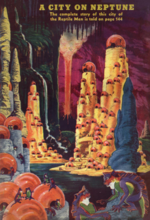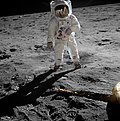The atmosphere of Triton is the layer of gases surrounding Triton. Like the atmospheres of Titan and Pluto, Triton's atmosphere is composed primarily...
38 KB (3,780 words) - 03:45, 4 July 2024
rounded under its own gravity and hosts a thin but well-structured atmosphere. Triton orbits Neptune in a retrograde orbit—an orbit in the direction opposite...
79 KB (7,899 words) - 04:57, 8 July 2024
Titan Atmosphere of Enceladus Atmosphere of Uranus Atmosphere of Titania Atmosphere of Neptune Atmosphere of Triton Atmosphere of Pluto The atmosphere of...
20 KB (2,076 words) - 08:11, 11 July 2024
Moons of Neptune (section Triton)
collided to form a rubble disc. Triton is massive enough to have achieved hydrostatic equilibrium and to retain a thin atmosphere capable of forming clouds...
54 KB (4,583 words) - 17:44, 12 July 2024
Neptune (redirect from Neptune's atmosphere)
it came within 4,400 km of Neptune's atmosphere on 25 August, then passed close to the planet's largest moon Triton later the same day. The spacecraft verified...
146 KB (14,326 words) - 15:24, 10 July 2024
climate of Triton encompasses the atmospheric dynamics, weather, and long-term atmospheric trends of Neptune's moon Triton. The atmosphere of Triton is rather...
21 KB (2,290 words) - 19:27, 11 July 2024
Umbriel's surface ice Neptune – the atmosphere contains 1.5 ± 0.5% methane Triton – Triton has a tenuous nitrogen atmosphere with small amounts of methane near...
103 KB (10,992 words) - 00:46, 26 June 2024
significant enough to drive weather (the other being the atmosphere of Triton). Titan's lower atmosphere is primarily composed of nitrogen (94.2%), methane...
58 KB (6,235 words) - 10:19, 14 July 2024
Earth and about 1⁄80 of its mass. The next largest ratios are the Neptune–Triton system at 0.055 (with a mass ratio of about 1 to 4790), the Saturn–Titan...
43 KB (3,569 words) - 15:46, 25 June 2024
known atmosphere. Its closest analog is the atmosphere of Triton, although in some aspects it resembles even the atmosphere of Mars. The atmosphere of Pluto...
59 KB (6,061 words) - 23:57, 5 May 2024
Operation Sandblast (redirect from USS Triton Submarine Memorial Park)
executed by the United States Navy nuclear-powered radar picket submarine USS Triton (SSRN-586) in 1960 under the command of Captain Edward L. Beach Jr. The...
128 KB (14,151 words) - 08:41, 8 June 2024
Planetary-mass moon (section Atmospheres)
Additionally, seven – Ganymede, Titan, Callisto, Io, Earth's Moon, Europa, and Triton – are larger and more massive than the dwarf planets Pluto and Eris. The...
30 KB (2,243 words) - 01:44, 17 June 2024
at low and mid latitudes. Launch took place in June 2019. Triton, The FORMOSAT-7R (TRITON) is a micro-satellite designed and manufactured by NSPO. It...
22 KB (2,018 words) - 21:36, 8 July 2024
Cryovolcano (section Triton)
Solar System Ruach Planitia and Tuonela Planitia, Triton Detail mosaic of Leviathan Patera, Triton Radar image of Doom Mons, Titan Ahuna Mons, Ceres Topography...
63 KB (6,361 words) - 01:00, 15 July 2024
Pluto (section Atmosphere)
Pluto and the most massive object discovered in the Solar System since Triton in 1846. Its discoverers and the press initially called it the tenth planet...
164 KB (14,233 words) - 19:27, 14 July 2024
Extraterrestrial sky (section The sky of Triton)
much closer to Neptune. Triton, Neptune's largest moon, has a hazy atmosphere composed primarily of nitrogen. Because Triton orbits with synchronous rotation...
52 KB (6,149 words) - 06:13, 30 June 2024
Neptune in fiction (redirect from Triton in fiction)
have ranged from humanoids to gaseous lifeforms. Neptune's largest moon Triton has also appeared in fiction, especially in the late 20th century onwards...
21 KB (1,965 words) - 21:42, 25 June 2024
atmosphere has been blasted away by the solar wind. The only moon that has retained a dense atmosphere is Titan. There is a thin atmosphere on Triton...
14 KB (1,532 words) - 08:31, 12 July 2024
known, having about two-thirds the mass of all irregular moons combined. (Triton is much larger, but is very unusual for an irregular satellite.) Nereid...
16 KB (1,446 words) - 00:02, 18 June 2024
Lellouch, E.; de Bergh, C.; Sicardy, B.; Ferron, S.; Käufl, H.-U. (2010). "Detection of CO in Triton's atmosphere and the nature of surface-atmosphere interactions"...
44 KB (3,995 words) - 00:35, 9 July 2024
renamed the TAO/TRITON array in recognition of the contribution made by the TRITON (Triangle Trans-Ocean Buoy Network) moorings. The TRITON moorings are...
8 KB (997 words) - 08:07, 15 August 2023
as soot in color. Triton was revealed as having a remarkably active past, with active geysers, polar caps, and a very thin atmosphere characterized by...
23 KB (2,496 words) - 10:34, 18 April 2024
including Ariel, Titania, Umbriel, Ceres, Dione, Mimas, Miranda, Oberon, Pluto, Triton, Eris, and Makemake. Outside the Solar System, exoplanets that have been...
52 KB (5,627 words) - 03:46, 23 June 2024
Cassini and before that by Voyager 2, which also encountered Neptune's moon Triton. All three bodies show evidence of once being dwarf planets, and their exploration...
97 KB (8,999 words) - 04:10, 10 July 2024
Kuiper belt (section Triton)
Quaoar, and Makemake. Some of the Solar System's moons, such as Neptune's Triton and Saturn's Phoebe, may have originated in the region. The Kuiper belt...
118 KB (13,220 words) - 00:22, 30 May 2024
Uranus (section Atmosphere)
combined mass of the five major satellites would be less than half that of Triton (largest moon of Neptune) alone. The largest of Uranus's satellites, Titania...
157 KB (15,532 words) - 07:04, 17 June 2024
learning more about Neptune's largest moon Triton, but also aim to gain more information about the atmosphere of Neptune. An analysis of a nuclear-electric...
16 KB (1,627 words) - 07:45, 12 June 2024
Makemake (redirect from Atmosphere of Makemake)
ices, there is nowhere near the same level of nitrogen as on Pluto and Triton, where it composes more than 98 percent of the crust. The relative lack...
53 KB (4,661 words) - 19:20, 29 June 2024
Neptunian moon Triton. On Pluto it was directly observed for the first time in July 2015 by the New Horizons space probe and on Triton it was directly...
50 KB (5,941 words) - 10:03, 24 May 2024



























